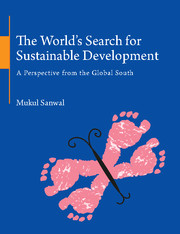Book contents
- Frontmatter
- Dedication
- Contents
- Preface
- Acknowledgments
- Abbreviations
- INTRODUCTION
- 1 Social Dimension of Sustainability
- CONSUMPTION IN AN UNEQUAL WORLD: FRAMING INTERNATIONAL COOPERATION
- CLIMATE POLICY: GLOBAL TO NATIONAL
- 6 Political Origins of Climate Policy
- 7 Questions on the Framework
- 8 Burden Shifting Rather than Burden Sharing
- 9 Development of a Shared Vision
- 10 The Middle Class and Global Ecological Limits
- 11 The New Climate Regime
- SUSTAINABLE DEVELOPMENT: NATIONAL TO GLOBAL
- CONSUMPTION IN A MORE EQUAL WORLD: SHAPING SOCIETAL FUNCTIONS
- GEOPOLITICS TO GEOECONOMICS: RURAL–URBAN DIVIDE, RATHER THAN BETWEEN COUNTRIES
- THE ASIAN CENTURY
- Index
9 - Development of a Shared Vision
from CLIMATE POLICY: GLOBAL TO NATIONAL
Published online by Cambridge University Press: 18 December 2015
- Frontmatter
- Dedication
- Contents
- Preface
- Acknowledgments
- Abbreviations
- INTRODUCTION
- 1 Social Dimension of Sustainability
- CONSUMPTION IN AN UNEQUAL WORLD: FRAMING INTERNATIONAL COOPERATION
- CLIMATE POLICY: GLOBAL TO NATIONAL
- 6 Political Origins of Climate Policy
- 7 Questions on the Framework
- 8 Burden Shifting Rather than Burden Sharing
- 9 Development of a Shared Vision
- 10 The Middle Class and Global Ecological Limits
- 11 The New Climate Regime
- SUSTAINABLE DEVELOPMENT: NATIONAL TO GLOBAL
- CONSUMPTION IN A MORE EQUAL WORLD: SHAPING SOCIETAL FUNCTIONS
- GEOPOLITICS TO GEOECONOMICS: RURAL–URBAN DIVIDE, RATHER THAN BETWEEN COUNTRIES
- THE ASIAN CENTURY
- Index
Summary
New policy approaches for the stalemated process
The Intergovernmental Panel on Climate Change has now acknowledged that how the burden of mitigating climate change should be divided among countries raises difficult questions of fairness, and rights, all of which are in the sphere of ethics [IPCC, 2014a]. How this fits into the four distinct policy measures for emission reductions – the Kaya identity – remains an unresolved issue. These elements are wealth, population, energy intensity (units of energy per unit of GDP) and carbon intensity (carbon produced per unit of energy). These levers involve population shifts from rural poverty to urban middle-class levels of well-being, consumption patterns, energy efficiency and modifying the fuel mix and how they interact with one another. The outcome is not dependent on a multilateral treaty or market, but on the substance of societal well-being.
The Intergovernmental Panel on Climate Change has now also observed that the methods of economics are concerned with value as well as measuring and aggregating the well-being of humans but not in taking account of justice and rights [IPCC, 2014b]. For example, there could be an overlap between the financial instruments with carbon pricing, because both policies address the same market failure and the high initial cost of the technology, but high prices have little impact on the practices that reflect societal change. Similarly, for the generation sector, energy efficiency standards have been found to be as effective as prices in reducing emissions. There is evidence of a stark trade-off between distributional impacts and policy efficiency depending on how the revenue is distributed. Carbon prices are also not applicable to long-lived assets, like building and transport infrastructure, where life cycle assessment of costs is involved.
According to projections of the International Energy Agency, global energy supply is estimated to increase three times by 2050, without including the requirements of access to energy by the poor. In contrast, during the past 100 years, energy use largely in industrialized countries increased 16 times. If a distinction is made between electricity demand and transportation, a very different picture emerges, as transportation emissions are projected to be half of the global emissions of carbon dioxide in 2050.
- Type
- Chapter
- Information
- The World's Search for Sustainable DevelopmentA Perspective from the Global South, pp. 140 - 146Publisher: Cambridge University PressPrint publication year: 2015

